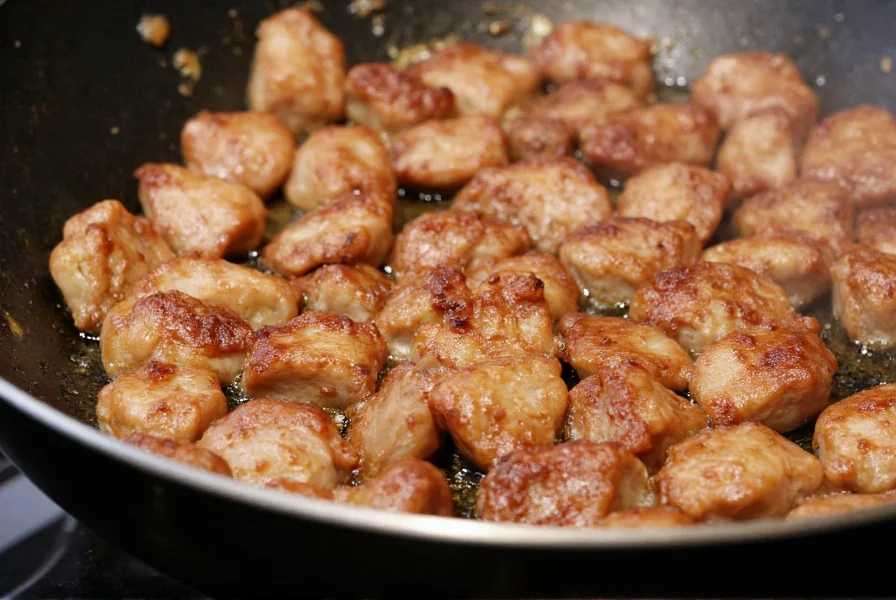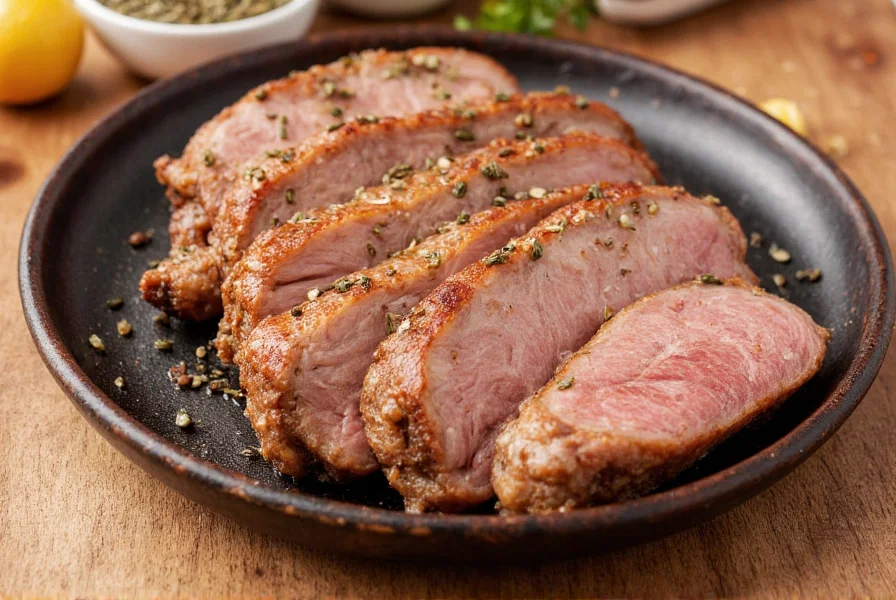Understanding the Essence of Salt and Pepper Pork
Unlike many Chinese dishes that rely on complex sauces, salt and pepper pork celebrates the purity of its two signature seasonings. The magic happens through technique rather than ingredients—the double-frying process creates extraordinary crispiness while preserving moisture inside. Many home cooks struggle with soggy results because they don't properly dry the pork before coating or fail to maintain consistent oil temperature, which are critical for achieving that signature crunch.
Ingredient Selection: Quality Matters
The beauty of this dish lies in its simplicity, making ingredient quality paramount. Each component serves a specific purpose in creating the perfect salt and pepper pork experience:
| Ingredient | Function | Professional Recommendation |
|---|---|---|
| Pork shoulder (butt) | Ideal fat-to-lean ratio for juicy results | Cut against the grain into uniform 1-inch cubes |
| Coarse sea salt | Provides texture and controlled salinity | Maldon or Himalayan pink salt for optimal flavor release |
| Freshly cracked black pepper | Essential aromatic complexity | Crack just before use; avoid pre-ground pepper |
| Cornstarch-flour blend | Creates ultra-crisp coating | 3:1 ratio cornstarch to flour for best texture |

Step-by-Step Preparation for Perfect Results
Follow this professional method for authentic salt and pepper pork that rivals restaurant quality:
- Prep the pork: Cut 1.5 lbs pork shoulder into uniform 1-inch cubes, removing large fat chunks. Pat completely dry with paper towels—this step is crucial for crispiness.
- Create the coating: Mix 1/4 cup cornstarch, 2 tbsp flour, 1 tsp five-spice powder (optional), and 1/2 tsp white pepper. For how to make crispy salt and pepper pork, proper coating is essential.
- First fry: Heat oil to 325°F (163°C). Fry pork in small batches for 3-4 minutes until lightly golden. Drain thoroughly on wire rack.
- Second fry: Increase oil to 375°F (190°C). Refry pork for 60-90 seconds until deeply golden and ultra-crisp. This double-frying technique creates the signature texture.
- Season: Immediately toss with 1.5 tsp coarse salt and 2 tsp freshly cracked black pepper. For traditional Chinese salt and pepper pork, timing this step correctly prevents sogginess.
Avoiding Common Preparation Mistakes
Understanding these pitfalls ensures perfect salt and pepper pork every time:
- Soggy texture: Caused by insufficient drying of pork or oil temperature dropping too low. Always dry pork thoroughly and maintain consistent oil temperature using a thermometer.
- Bland flavor: Using pre-ground pepper instead of freshly cracked. The volatile oils in freshly cracked pepper provide the distinctive aroma that defines this dish.
- Overly salty: Adding salt before frying. Always season immediately after the final fry while the pork is still hot for optimal flavor absorption.
- Inconsistent results: Not cutting pork to uniform size. For best results with salt and pepper pork recipe, ensure all pieces are the same size for even cooking.
Variations Across Chinese Culinary Traditions
While the classic preparation remains popular, regional adaptations offer exciting alternatives:
- Hong Kong style: Includes a small amount of fresh chili threads for subtle heat that complements the pepper
- Taiwanese version: Adds a touch of five-spice powder to the seasoning mix for additional complexity
- Health-conscious adaptation: Air-fry method that maintains crispiness with significantly less oil, perfect for salt and pepper pork recipe without deep frying
- Restaurant technique: Some high-end establishments add a small amount of Sichuan peppercorns for a subtle numbing sensation

Perfect Pairings and Serving Techniques
Salt and pepper pork reaches its full potential when served thoughtfully. The traditional Chinese preparation serves it with:
- Steamed jasmine rice to balance the rich, savory flavors
- Simple stir-fried greens like gai lan or bok choy for freshness
- A light dipping sauce of lime juice, chili, and a touch of sugar
- As part of a larger meal with egg drop soup and steamed dumplings
For an authentic experience, serve immediately after preparation while the coating remains maximally crisp. The dish works equally well as an appetizer or main course, making it versatile for different dining occasions.
Storage and Reheating Guidelines
While best enjoyed fresh, properly handled salt and pepper pork maintains quality:
- Refrigeration: Store in airtight container for up to 3 days; separate from any sauce
- Reheating: Use oven or air fryer at 350°F for 5-7 minutes (never microwave)
- Freezing: Not recommended as texture suffers significantly during thawing
- Reviving crispiness: Place on wire rack in oven rather than plate to prevent steaming
The key to maintaining texture is dry heat—the oven or air fryer works much better than a microwave, which creates steam and softens the delicate coating. For best results when reheating salt and pepper pork, avoid stacking pieces and allow air circulation.
Frequently Asked Questions
What's the best cut of pork for salt and pepper pork?
Pork shoulder (also called pork butt) is ideal for salt and pepper pork because it has the perfect balance of lean meat and fat marbling. This cut stays juicy during frying while developing excellent crispiness. Avoid lean cuts like tenderloin, which will dry out during the double-frying process. For authentic salt and pepper pork, the 20-30% fat content in pork shoulder creates the ideal texture contrast.
Can I make salt and pepper pork without deep frying?
Yes, you can achieve good results with an air fryer. Pat the pork extremely dry, coat with the cornstarch mixture, and air fry at 400°F (200°C) for 12-15 minutes, shaking the basket halfway through. While not quite as crispy as deep-fried version, it's a healthier alternative that still delivers great flavor. For salt and pepper pork recipe without deep frying, consider adding a light spray of oil during cooking to enhance browning.
Why is my salt and pepper pork not crispy?
Several factors can cause lack of crispiness: insufficient drying of pork before coating, oil temperature too low during frying, overcrowding the fryer, or adding salt too early. For maximum crispiness, ensure pork is completely dry, maintain oil at 350°F during first fry and 375°F for second fry, and only add salt after the final frying. The cornstarch-to-flour ratio in your coating also significantly impacts crispiness.
What's the difference between salt and pepper pork and salt and pepper chicken?
The main differences are cooking time and temperature. Pork requires higher initial frying temperature (325°F) and longer cooking time than chicken because of its density. Pork shoulder needs about 3-4 minutes for the first fry, while chicken would only need 2-3 minutes. The seasoning ratio remains the same, but pork benefits from slightly more pepper to complement its richer flavor. For traditional Chinese salt and pepper pork, the double-frying technique is more critical than with chicken due to pork's higher fat content.
What dipping sauce pairs best with salt and pepper pork?
The classic pairing is a simple mixture of lime juice, chili, and a touch of sugar. Some variations include a light soy-vinegar dip or a garlic-chili oil. For authentic salt and pepper pork experience, avoid heavy sauces that would overwhelm the delicate seasoning. Many Chinese restaurants serve it with just a wedge of lime on the side to let the main flavors shine.











 浙公网安备
33010002000092号
浙公网安备
33010002000092号 浙B2-20120091-4
浙B2-20120091-4